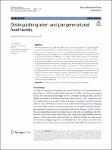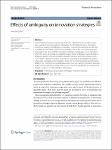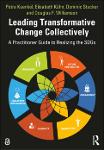Search
Author
- Marina, Dabić (3)
- Christa, Sys (2)
- Domingo, Ribeiro-Soriano (2)
- Gittell, Ross (2)
- next >
Subject
- kinh tế (26)
- Economics (12)
- Management science (7)
- Development Economics (6)
- next >
Date issued
- 2020 - 2023 (306)
- 2010 - 2019 (47)
- 2009 - 2009 (1)
Has File(s)
- true (354)
Search Results
We propose a novel approach to check whether individual behaviour in binary-choice participation games is consistent with the restrictions imposed by symmetric models. This approach allows in particular an assessment of how much cluster-heterogeneity a symmetric model can tolerate to remain consistent with its behavioural restrictions. We assess our approach with data from market-entry experiments which we analyse through the lens of ‘Exploration versus Exploration’ (EvE, which is equivalent to Logit-QRE) or of Impulse Balance Equilibrium (IBE). |
The aim of this article is to analyze how the concept of circular economy and especially the business model of industrial symbiosis can contribute to sustainable development in Uganda. We aim to add to emerging debates around green industrial policies by shedding light on a low-cost solution that can potentially promote a more sustainable industrialization in the Sub-Saharan African context. After sketching the regulatory and policy environment in Uganda, three indicative examples of industrial symbiosis in Uganda are analyzed, based on the result of field research and an online survey. |
While food trends are usually described over an entire population, this paper suggests distinguishing between inter- and pangenerational food trends. To classify the food trends for the total population as inter- or pangenerational, we used disaggregated household-based consumption data on 60 food categories over the period from 1990 to 2020 in Switzerland. We followed six different cohorts with a range of 10 birth years each and estimated robust trends for each generation and each product. Our results show that especially for meat, different generations follow different trends and form ‘intergenerational’ trends for the total population, whereas beans and peas would be an example of products with an increasing consumption for every single generation and a ‘pangenerational’ trend. |
Women’s entrepreneurship is the pillar of economic expansion in many developing countries and is increasingly recognized as an essential driver of economic growth, productivity, innovation, employment, and economic dynamism. This study aimed to investigate the socio-economic factors that affect women’s entrepreneurial performance in MSEs in Bahir Dar City, Ethiopia. This study employed explanatory and descriptive survey designs using a quantitative research approach. The data were gathered from a survey of 348 registered women-owned MSEs. Statistical models, including factor analysis, correlation, and regression analysis, were used to look for patterns and relationships between variables apart from other descriptive statistics. |
This open access book questions the stereotype depicting all Gulf (GCC) economies as not sustainable, and starts a critical discussion of what these economies and polities should do to guarantee themselves a relatively stable future. Volatile international oil markets and the acceleration of the energy transition has challenged the notion that oil revenues are sufficient to sustain oil economies in the near to medium term. But what is the meaning of economic sustainability? The book discusses the multiple dimensions of the concept: economic diversification, continuing value of resources, taxation and fiscal development, labor market sustainability, sustainable income distribution, environmental sustainability, political order (democracy or authoritarianism) and sustainability, regio... |
Technological innovations significantly influence individual firms and other innovations, such as financial innovations. The future of a firm depends on its innovation investment strategy. According to the literature, innovation investments are affected by ambiguity. This study examines how ambiguity affects the innovation strategies of managers. We show that the innovation strategies of ambiguity-averse managers differ from those of ambiguity-neutral managers. Unlike ambiguity-neutral managers, ambiguity-averse managers consider a broader variety of innovation strategies for a wider range of future innovation arrival times. |
This book directly helps decision-makers and change agents in companies, NGOs, and government bodies become more proficient in transformative, collaborative change in realizing the SDGs. This practitioner’s handbook translates a systemic – and enlivening – approach to collaboration into day-to-day work and management. It connects the emerging practice of multi-stakeholder collaboration to easily understandable models, tools, and cases. Numerous, concrete cases not only bring this methodology to life, but also help identify the challenges and avoid common mistakes. The book can be used as a guide to apply a breakthrough approach for navigating the complexity of stakeholder systems, designing results-oriented process architectures, ensuring the success of cross-sector change initiativ... |
Refugee and migrant (mixed migration) flows in the Mediterranean have been in the spotlight of both policy and research, especially since 2015. Mixed migration is a volatile international phenomenon with considerable and debatable impacts on society and economy. This paper investigates the performance of time series forecasting methods based on EUROSTAT datasets focusing on asylum seekers. Germany has been selected to reflect on the ability of the models to predict the future behavior of an extremely volatile migrant mobility. Exponential smoothing and autoregressive integrated moving average (ARIMA) models have been used for the forecasting of asylum seekers. Monthly records of first-time asylum seekers have been used from January of 2008 up to September of 2020. The results demons... |
The optimal management of scarce transboundary water resources among competitive users is expected to be challenged by the effects of climate change on water availability. The multiple economic and social implications, including conflicts between neighbouring countries, as well as competitive sectors within each country are difficult to estimate and predict, to inform policy-making. In this paper, this problem is approached as a stochastic multistage dynamic game: we develop and apply a novel framework for assessing and evaluating different international strategies regarding transboundary water resources use, under conditions of hydrological uncertainty. |
In this paper, we discuss the classical modelling approach of pandemics as a negative labour shock. We perform an archival analysis of one of the largest Italian banks (Credito Italiano) during the First World War – Spanish Flu period (1914–1920). In particular, we scrutinise the circulars that the central management of the bank sent out to the local branches, with the aim to assess whether the Spanish Flu has been perceived by contemporaries as an event seriously affecting personnel management. Though restricted to a single case-study, archival evidence does not support the existence of a remarkable negative labour supply shock affecting personnel management because of the Spanish Flu pandemic. Other war-related events probably increased the system’s resilience. |










